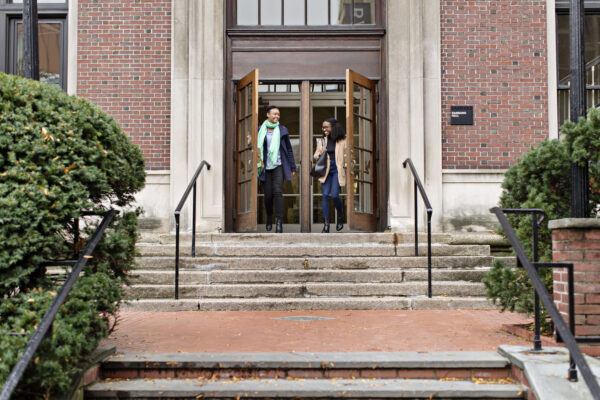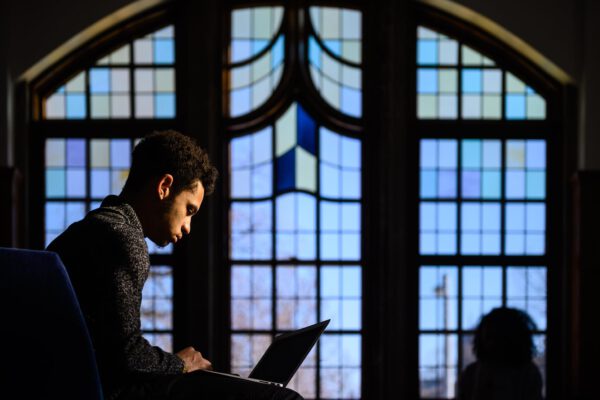By Mary B. Marcy. Dr. Marcy is president of Dominican University of California, one of two recipients of the 2020 ACE/Fidelity Investments Award for Institutional Transformation. The award was created to recognize institutions that have responded to higher education challenges.
The media, as well as most of our campuses and boards, are consumed right now with the immediate and significant challenge of delivering quality education while attempting to contain the spread of the coronavirus. But many institutions are also facing a different kind of existential risk: a risk to the continuation of their mission. Meeting the moment will require more than surviving the pandemic, although survive it we must. It will require planning for long-term adaptation even as we navigate the whitewater of the present.
As the president of a small independent university just recognized as a national leader in transformation, I can attest to both the necessity of change in higher education and to the challenge that lies ahead for our campuses and our country.
Keeping small colleges and universities functioning through the pandemic matters. Our missions and the opportunities our institutions provide are needed now more than ever. Ensuring these missions endure after the pandemic is also crucial. It will take more than another federal stimulus package to make it happen, although that is desperately needed. Securing the short-term survival and the long-term sustainability of these institutions involves at least four essential steps, steps that involve both the institutions themselves and our state and federal leadership.
First, government-backed loans need to be made available to nonprofit colleges and universities, especially small and regional campuses, and they need to be made available soon. Many of our campuses, dependent on rentals and camps in the summer, and even more dependent on tuition and housing revenue in the fall, are facing cash flow challenges that are quickly escalating. Added to these revenue losses are the expenses associated with the pandemic, from investments in personal protective equipment to the costs of essential routine testing.

For the most part, these revenue losses and increased expenses are one-time budget hits, not the ongoing cost of doing business. A lending program that incentivizes banks to provide help to our institutions would shore up the vast majority of campuses that, if supported through this period, can adjust to changing realities for the long run and be highly viable.
Second, our campuses need to adapt, and do so more rapidly than is usually the case in higher education. Even higher education can move quickly, as evidenced by the stunning rapid shift to online education by virtually all campuses last spring. But to do this well and adapt for the long term will require more thoughtful, thorough, and fundamental change.
It is possible to undertake substantial change within the bounds and spirit of shared governance. The most essential innovations will respond to the changes in the student profile, changes that have begun in earnest and will only accelerate in the coming decades. Contemporary students reflect the nation, and national demographics are shifting. More than in the past—more than most of our institutional structures originally envisioned—students today are often working to help pay for college, they are often students of color, they are frequently financially needy, and they may well be the first in their family to attend college. There is also a rapidly growing demographic of adult learners, whose needs differ markedly from the traditional-aged student.
For these students to be successful, they need more streamlined curricula, integrated support systems, and clear pathways to and through college. For example, at my institution Dominican University of California, we developed a signature program focused on supporting this changing demographic with outstanding results as shown in student persistence to graduation. As we move through and beyond the pandemic, adapting to changing demographics will no longer be a strategic option for small colleges and universities, it will be a condition of survival.
Third, institutions must address the broken business model of higher education. The high tuition-high financial aid approach is no longer yielding sufficient revenue for campuses, and it not affordable for students and families. Of course, this is not an easy structure to change, as it involves unbundling many core services and a deep assessment of how programs and courses are delivered. But there are some intriguing new approaches to addressing the business model challenge.
A few colleges and universities have adopted income share agreements—essentially a different form of loan—that provide students with the education first, then the institutions receive repayment based on a portion of the student’s income after employment. Other institutions are exploring new types of consortia and collaboration utilizing emerging technology to provide a wider range of academic programs—and offering them more quickly than they could manage if fully developed on campus. Other consortia are expanding beyond sharing the typical back-office functions and looking to provide more bespoke programs to their communities. My own campus is engaged in a pilot program with the state of California that provides scholarships and paid internships in return for public service. Each of these nascent programs merit evaluation, adjustment, and potential expansion.
Finally, small colleges and universities must become full partners in the economic and social recovery of the nation. The focus of small colleges is student learning and student success, not research or athletics. It is these institutions that will nurture the personal and professional skills students need to be gainfully employed and contribute to society. The state and federal government should support the kinds of innovation outlined here by strategically investing in programs that promise greater access and student success, by ensuring financial aid is fully supported and encouraging accreditors to support innovation while maintaining high standards for academic integrity.
This nation needs the economic and social opportunities generated by its small colleges and universities. We have the capacity to secure it. Whether we will do so remains an open question.
If you have any questions or comments about this blog post, please contact us.


